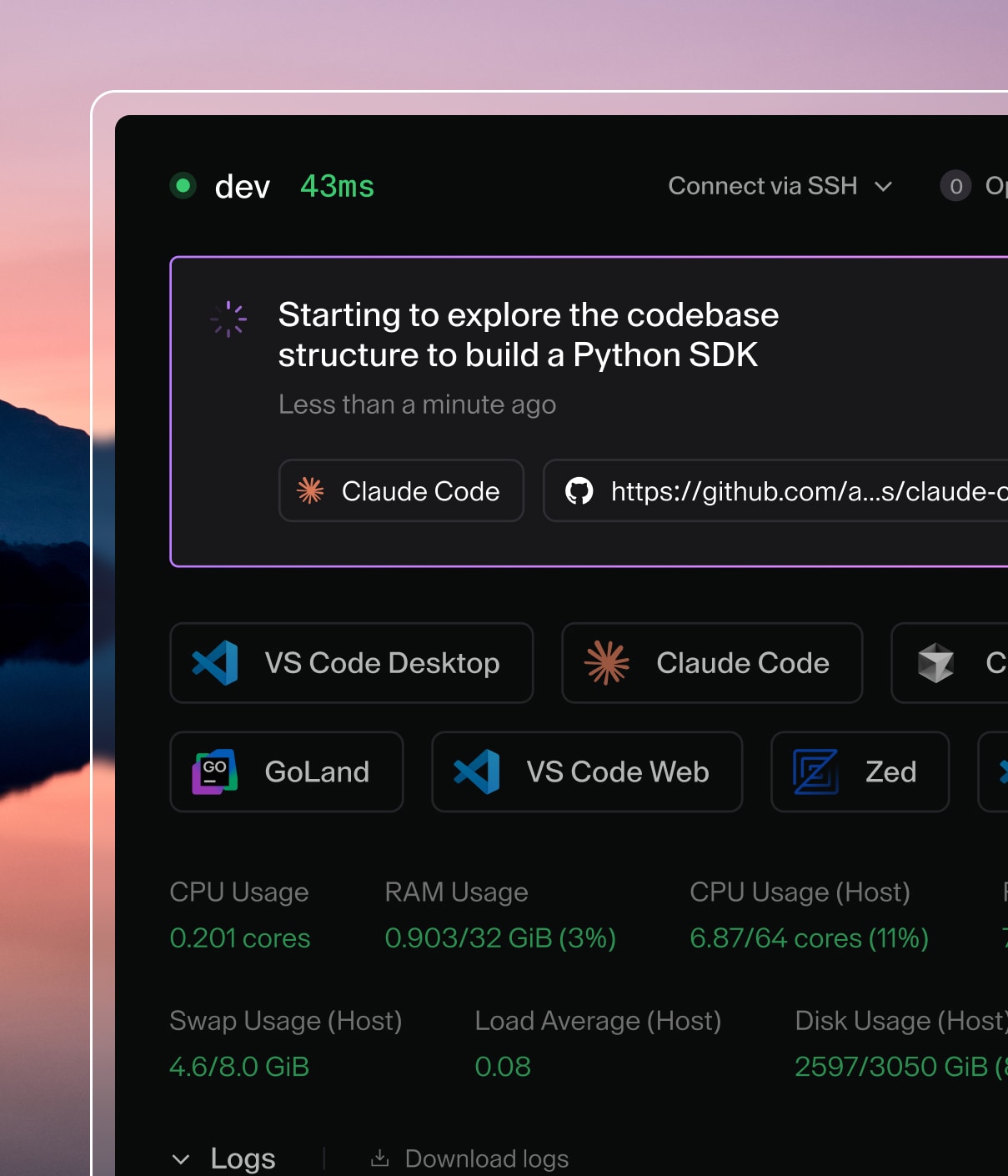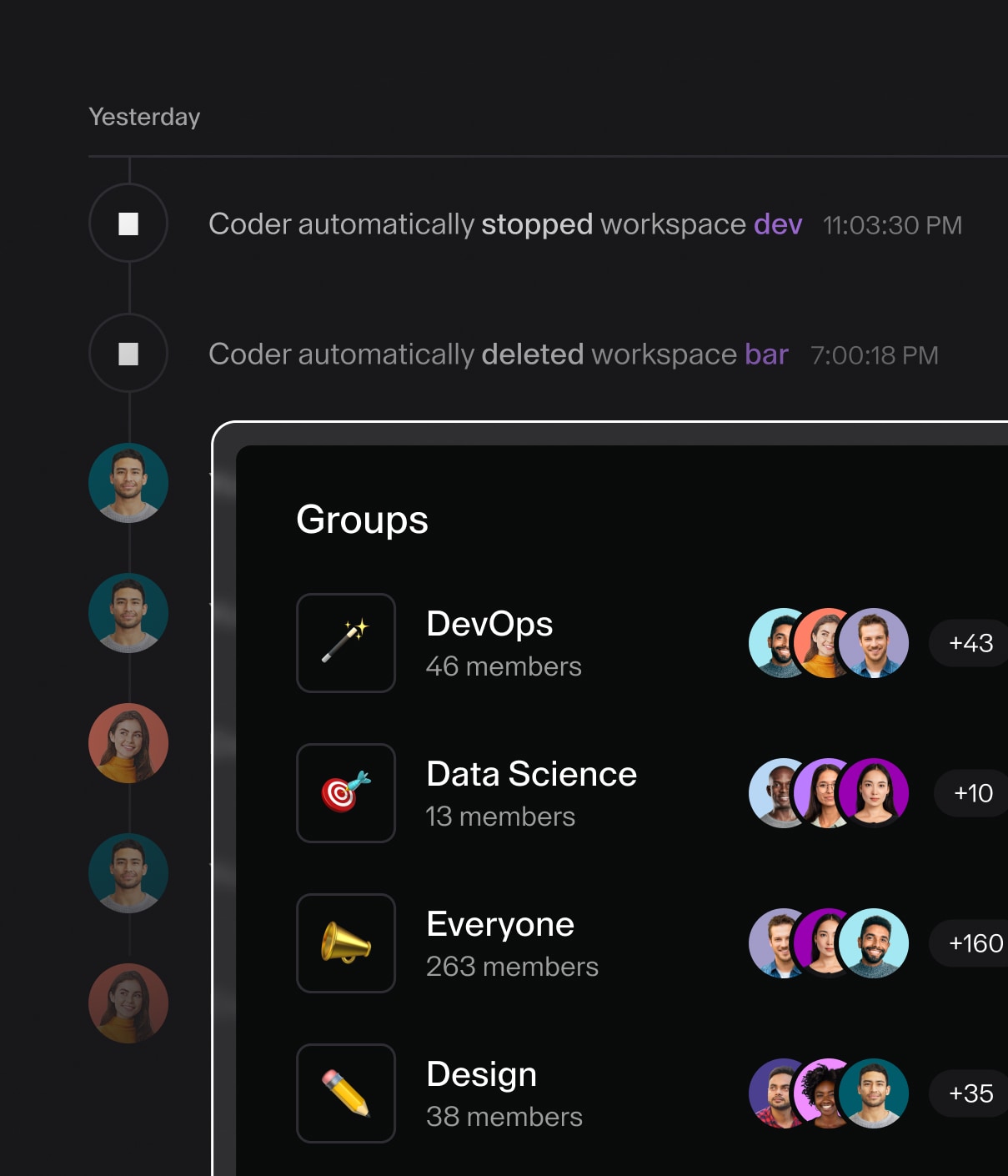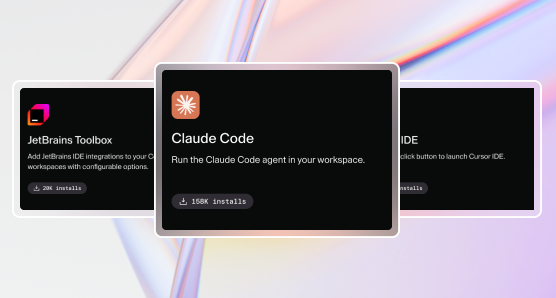Client Configuration
Once AI Bridge is setup on your deployment, the AI coding tools used by your users will need to be configured to route requests via AI Bridge.
Base URLs
Most AI coding tools allow the "base URL" to be customized. In other words, when a request is made to OpenAI's API from your coding tool, the API endpoint such as /v1/chat/completions will be appended to the configured base. Therefore, instead of the default base URL of "https://api.openai.com/v1", you'll need to set it to "https://coder.example.com/api/v2/aibridge/openai/v1".
The exact configuration method varies by client — some use environment variables, others use configuration files or UI settings:
- OpenAI-compatible clients: Set the base URL (commonly via the
OPENAI_BASE_URLenvironment variable) tohttps://coder.example.com/api/v2/aibridge/openai/v1 - Anthropic-compatible clients: Set the base URL (commonly via the
ANTHROPIC_BASE_URLenvironment variable) tohttps://coder.example.com/api/v2/aibridge/anthropic
Replace coder.example.com with your actual Coder deployment URL.
Authentication
Instead of distributing provider-specific API keys (OpenAI/Anthropic keys) to users, they authenticate to AI Bridge using their Coder session token or API key:
- OpenAI clients: Users set
OPENAI_API_KEYto their Coder session token or API key - Anthropic clients: Users set
ANTHROPIC_API_KEYto their Coder session token or API key
Again, the exact environment variable or setting naming may differ from tool to tool; consult your tool's documentation.
Configuring In-Workspace Tools
AI coding tools running inside a Coder workspace, such as IDE extensions, can be configured to use AI Bridge.
While users can manually configure these tools with a long-lived API key, template admins can provide a more seamless experience by pre-configuring them. Admins can automatically inject the user's session token with data.coder_workspace_owner.me.session_token and the AI Bridge base URL into the workspace environment.
In this example, Claude code respects these environment variables and will route all requests via AI Bridge.
This is the fastest way to bring existing agents like Roo Code, Cursor, or Claude Code into compliance without adopting Coder Tasks.
data "coder_workspace_owner" "me" {}
data "coder_workspace" "me" {}
resource "coder_agent" "dev" {
arch = "amd64"
os = "linux"
dir = local.repo_dir
env = {
ANTHROPIC_BASE_URL : "${data.coder_workspace.me.access_url}/api/v2/aibridge/anthropic",
ANTHROPIC_AUTH_TOKEN : data.coder_workspace_owner.me.session_token
}
... # other agent configuration
}
Using Coder Tasks
Agents like Claude Code can be configured to route through AI Bridge in any template by pre-configuring the agent with the session token. Coder Tasks is particularly useful for this pattern, providing a framework for agents to complete background development operations autonomously. To route agents through AI Bridge in a Coder Tasks template, pre-configure it to install Claude Code and configure it with the session token:
data "coder_workspace_owner" "me" {}
data "coder_workspace" "me" {}
data "coder_task" "me" {}
resource "coder_agent" "dev" {
arch = "amd64"
os = "linux"
dir = local.repo_dir
env = {
ANTHROPIC_BASE_URL : "${data.coder_workspace.me.access_url}/api/v2/aibridge/anthropic",
ANTHROPIC_AUTH_TOKEN : data.coder_workspace_owner.me.session_token
}
... # other agent configuration
}
# See https://registry.coder.com/modules/coder/claude-code for more information
module "claude-code" {
count = data.coder_task.me.enabled ? data.coder_workspace.me.start_count : 0
source = "dev.registry.coder.com/coder/claude-code/coder"
version = ">= 4.0.0"
agent_id = coder_agent.dev.id
workdir = "/home/coder/project"
claude_api_key = data.coder_workspace_owner.me.session_token # Use the Coder session token to authenticate with AI Bridge
ai_prompt = data.coder_task.me.prompt
... # other claude-code configuration
}
# The coder_ai_task resource associates the task to the app.
resource "coder_ai_task" "task" {
count = data.coder_task.me.enabled ? data.coder_workspace.me.start_count : 0
app_id = module.claude-code[0].task_app_id
}
External and Desktop Clients
You can also configure AI tools running outside of a Coder workspace, such as local IDE extensions or desktop applications, to connect to AI Bridge.
The configuration is the same: point the tool to the AI Bridge base URL and use a Coder API key for authentication.
Users can generate a long-lived API key from the Coder UI or CLI. Follow the instructions at Sessions and API tokens to create one.
Compatibility
The table below shows tested AI clients and their compatibility with AI Bridge. Click each client name for vendor-specific configuration instructions. Report issues or share compatibility updates in the aibridge issue tracker.
| Client | OpenAI support | Anthropic support | Notes |
|---|---|---|---|
| Claude Code | - | ✅ | Works out of the box and can be preconfigured in templates. |
| Claude Code (VS Code) | - | ✅ | May require signing in once; afterwards respects workspace environment variables. |
| Cursor | ❌ | ❌ | Support dropped for v1/chat/completions endpoints; v1/responses support is in progress #16 |
| Roo Code | ✅ | ✅ | Use the OpenAI Compatible provider with the legacy format to avoid /v1/responses. |
| Codex CLI | ⚠️ | N/A | • Use v0.58.0 (npm install -g @openai/[email protected]). Newer versions have a bug breaking the request payload. • gpt-5-codex support is in progress. |
| GitHub Copilot (VS Code) | ✅ | ❌ | Requires the pre-release extension. Anthropic endpoints are not supported. |
| Goose | ❓ | ❓ | |
| Goose Desktop | ❓ | ✅ | |
| WindSurf | ❌ | ❌ | No option to override the base URL. |
| Sourcegraph Amp | ❌ | ❌ | No option to override the base URL. |
| Kiro | ❌ | ❌ | No option to override the base URL. |
| Copilot CLI | ❌ | ❌ | No support for custom base URLs and uses a GITHUB_TOKEN for authentication. |
| Kilo Code | ✅ | ✅ | Similar to Roo Code. |
| Gemini CLI | ❌ | ❌ | Not supported yet. |
| Amazon Q CLI | ❌ | ❌ | Limited to Amazon Q subscriptions; no custom endpoint support. |
Legend: ✅ works, ⚠️ limited support, ❌ not supported, ❓ not yet verified, — not applicable.
Compatibility Overview
Most AI coding assistants can use AI Bridge, provided they support custom base URLs. Client-specific requirements vary:
- Some clients require specific URL formats (for example, removing the
/v1suffix). - Some clients proxy requests through their own servers, which limits compatibility.
- Some clients do not support custom base URLs.
See the table in the compatibility section above for the combinations we have verified and any known issues.


